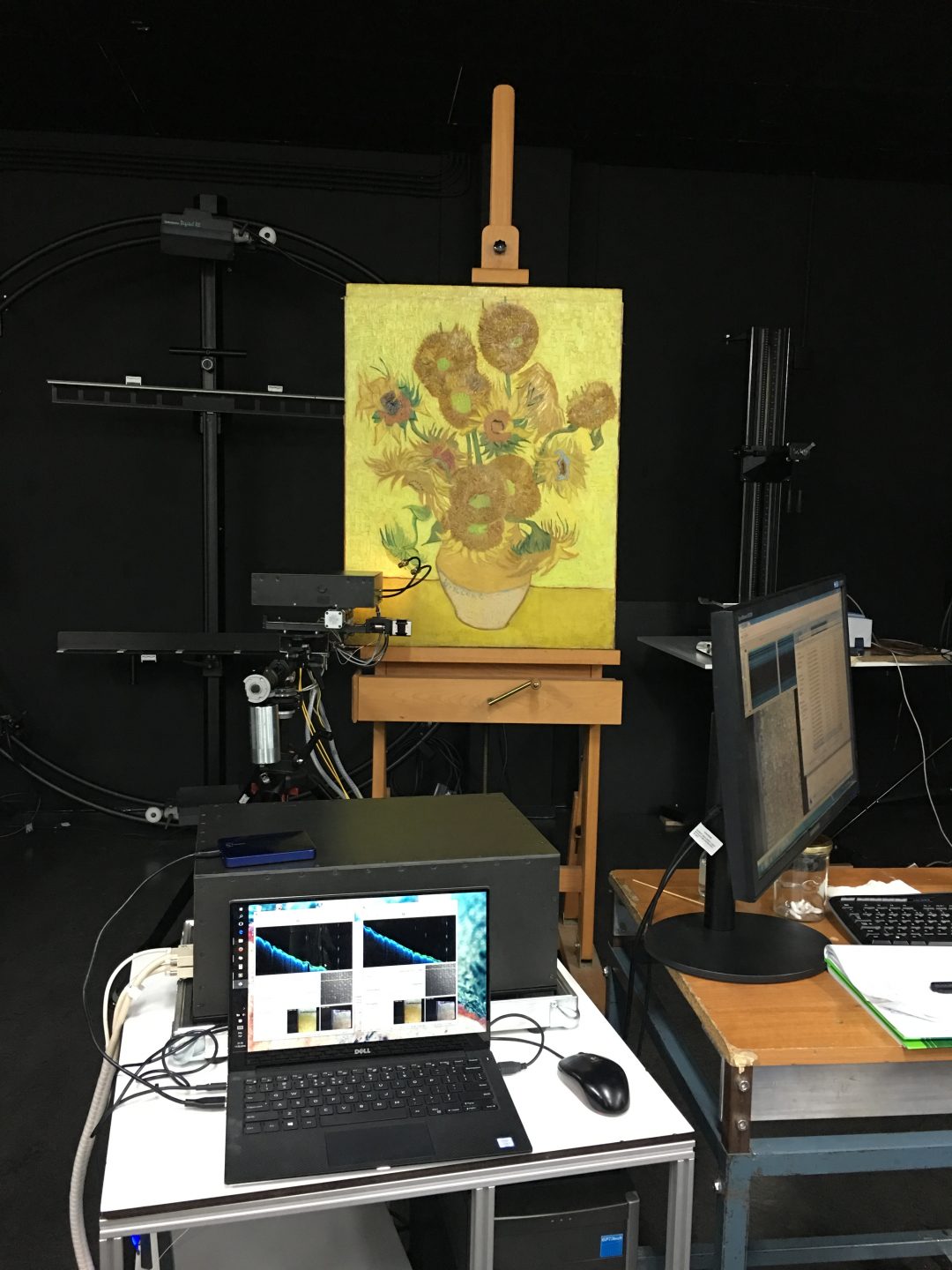User:: Koen Janssens
https://www.vangoghmuseum.nl/
Venue: Van Gogh Museum, Amsterdam, The Netherlands
Over the past two decennials at the Van Gogh Museum, conservators, scientists, and art historians have worked closely together to investigate Van Gogh’s working method. Campaigns of technical examinations have greatly enhanced the knowledge of the materials and techniques he used.
Specifically, color changes have been an aspect that repeatedly came to light during campaigns of physical examination such as the darkening of chrome yellow paint areas, often coupled with signs of physical deterioration, thus forming the main focal point of MOLAB access for the painting ‘Sunflowers’. Main aims of this project were to investigate in detail the relationship between a) the type(s) of chrome yellow employed and b) the admixture of pigments employed by Van Gogh. Additionally, the intention was to carry out cleaning tests for varnish removal and to permit a determination of the appropriate protocol/sequence of removal steps.
MOLAB Italy
The entire painting surface was analyzed by means of Vis-hyperspectral imaging [acquisition of 24 frames in total- size of about 20 cm (v)×25 cm (h); spectral resolution: ~4nm]. Selected areas of the painting were investigated by acquiring a series of UV-Vis point measurements (28 in total: n. 18 reflectance spectra; n. 10 fluorescence spectra) and Raman single-point spectra (76 in total). UV-Vis point measurements were performed by using a spatial resolution of ~ 1.5 mm2 and a spectral resolution of 8 nm and 20 nm in the UV-Vis and NIR range, respectively. A 445 nm diode laser (nominal power of ~0.5 mW) was used as excitation source for UV-Vis fluorescence analysis using the same spatial and spectral resolution. Raman spectra were collected by employing a 785 nm diode laser source with 4-8 mW power, 1-3 s exposure time and 1-5-scans.
Raman spectroscopy was successfully used for distinguishing among different types of chrome yellows and oranges and for identifying the molecular nature of a selection of red and blue inorganic pigments.
UV-Vis spectroscopy (hyperspectral+point measurements) permitted an insight into the chemical composition of the green, ochre-orange and purple hues of the painting.
Reflection FTIR measurements permitted the presence of a synthetic varnish to be identified and were also used for the monitoring of spot cleaning tests made along the edges of the painting.
MOLAB Poland
The Optical Coherence Tomography (OCT) examination was performed with the instrument built specifically for examination of artwork at Nicolaus Copernicus University within the FP7 CHARISMA project (GA 228330). The examination was performed in 44 spots chosen from inspection of the IPERION CH – Integrated Project for the European Research Infrastructure ON Cultural Heritage painting in a visible light and of UV-excited fluorescence. Altogether 77 3D data cubes have been collected and converted into ca 11 500 cross-sectional images (tomograms). The OCT examination was performed at the photographic studio of The Van Gogh Museum in parallel with FTIR inspection by MOLAB 1 permitting data collection in the same spots for comparison of results.
Pertinent OCT results permitted the varnish and relative thickness to be distinguished, different stages of soap formations and areas of retouching to be recognized. OCT was able to provide precise information regarding the cleaning tests on the thickness or amount of material removed as well as the evenness of the process.
From an art historical perspective, this study is expected to contribute towards a renewed appreciation of the color schemes in Van Gogh’s paintings that have been altered by darkened passages of chrome yellow. Findings could encourage revised interpretations of individual works and may help to redefine Van Gogh’s development as a painter as a whole and his important role as a colorist. Beyond scholarly circles, findings from this intervention will also be of strong interest to a general and museum public.
Given the broad appeal of Van Gogh’s paintings, especially in view of their highly expressive use of color, the research carried out is anticipated to attract worldwide interest and have a strong media
impact.

